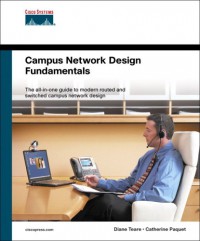
Cisco Press, Campus Network Design Fundamentals ,Dec.2005
ISBN: 9781587052224
File size: 3.44MB
The all-in-one guide to the what, why, and how of modern campus network design * Provides a “readers digest” overview of modern technologies used to build resilient, scalable campus infrastructures * Shows readers how to build switched and routed networks that securely support IP Telephony, QoS, and Wireless LANs * Illustrates application of the enabling technologies through sample network designs for headquarters, branch offices, and home office/remote users For enterprises to take advantage of cost-saving, productivity-enhancing solutions, such as IP telephony and Wireless LANs, their core infrastructure must include the key enabling technologies required by these solutions and provide a resilient, secure foundation that can scale to business needs. As with any architecture, designing a solid foundation is the first step. Over the past decade, campus network design has evolved many times as new technologies have emerged and business needs have changed. IP telephony, IP video, and e-learning, allow enterprises to increase productivity. Wireless LANs expand the workplace to allow information and application access beyond an employee’s desktop. Meanwhile, Internet worms and viruses are on the rise, increasing the need to find ways to protect networks and data, and to ensure the availability of the network resources. Campus Network Design Fundamentals is an all-in-one guide to switched Ethernet design that instructs readers on key LAN infrastructure components. The book provides insight into why each technology is important and how to apply this knowledge to create a campus network that includes as many or as few of today’s productivity-enhancing applications as are needed in any given environment. Key topics covered through-out the book include switching, IP routing, Quality of Service (QoS), security, wireless LANs, voice transport, content networking, network management, IPv6, IP multicast, and storage networking.
Download: link 1 | link 2 | link 3 | link 4